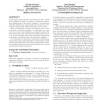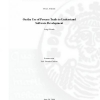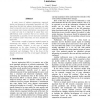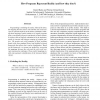WCRE
2006
IEEE
14 years 9 months ago
2006
IEEE
WCRE
2006
IEEE
14 years 9 months ago
2006
IEEE
Jointly deployed aspects may interact with each other. While some interactions might be intended, unintended interactions (interferences) can break a program. Detecting and resolv...
WCRE
2006
IEEE
14 years 9 months ago
2006
IEEE
Current literature on the topic of duplicated (cloned) code in software systems often considers duplication harmful to the system quality and the reasons commonly cited for duplic...
WCRE
2006
IEEE
14 years 9 months ago
2006
IEEE
In this demonstration, we present MELIS (Migration Environment for Legacy Information Systems) an integrated environment for the migration of legacy systems to a multi-tier web-ba...
WCRE
2006
IEEE
14 years 9 months ago
2006
IEEE
WCRE
2006
IEEE
14 years 9 months ago
2006
IEEE
In many areas of software engineering, empirical studies are playing an increasingly important role. This stems from the fact that software technologies are often based on heurist...
WCRE
2006
IEEE
14 years 9 months ago
2006
IEEE
Often, the only sources of information about the evolution of software systems are the systems themselves and their histories. Version control repositories contain information on ...
WCRE
2006
IEEE
14 years 9 months ago
2006
IEEE
An Executable Concept Slice extracts from a program an executable subprogram that captures the semantics of a specified high-level concept from the program. Executable concept sl...
WCRE
2006
IEEE
14 years 9 months ago
2006
IEEE
The understanding of the structure of a software system can be improved by analyzing the system’s evolution during development. Visualizations of software history that provide o...
WCRE
2006
IEEE
14 years 9 months ago
2006
IEEE
Programming is modeling the reality. Most of the times, the mapping between source code and the real world concepts is captured implicitly in the names of identifiers. Making the...




